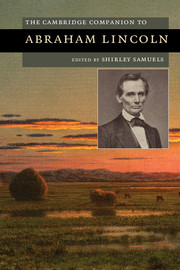Book contents
- Frontmatter
- Introduction
- 1 Rhetorically Lincoln: Abraham Lincoln and Oratorical Culture
- 2 Abraham Lincoln and Poetry
- 3 Seeing Lincoln: Visual Encounters
- 4 Lincoln's Gettysburg Address and Second Inaugural Address
- 5 Lincoln and the Natural Nation
- 6 Abraham Lincoln and the American Indians
- 7 Abraham Lincoln and the Self-Governing Constitution
- 8 Abraham Lincoln and Spiritual Crisis
- 9 America and Britain during the Civil War
- 10 Lincoln in International Memory
- 11 Lincoln's Hemispheric Relations
- 12 Lincoln on Hallowed Ground
- Guide to Further Reading
- Index
4 - Lincoln's Gettysburg Address and Second Inaugural Address
Published online by Cambridge University Press: 28 September 2012
- Frontmatter
- Introduction
- 1 Rhetorically Lincoln: Abraham Lincoln and Oratorical Culture
- 2 Abraham Lincoln and Poetry
- 3 Seeing Lincoln: Visual Encounters
- 4 Lincoln's Gettysburg Address and Second Inaugural Address
- 5 Lincoln and the Natural Nation
- 6 Abraham Lincoln and the American Indians
- 7 Abraham Lincoln and the Self-Governing Constitution
- 8 Abraham Lincoln and Spiritual Crisis
- 9 America and Britain during the Civil War
- 10 Lincoln in International Memory
- 11 Lincoln's Hemispheric Relations
- 12 Lincoln on Hallowed Ground
- Guide to Further Reading
- Index
Summary
Among the political scriptures of the United States, Lincoln's Gettysburg Address and Second Inaugural Address, each an object of voluminous commentary and interpretation, stand preeminent. Even the Declaration of Independence, for all the stirring reverberations of its memorable opening and closing, includes an extended middle section, an inventory of specific grievances against King George III, that is rhetorically closer to legal documentation than to anything in Lincoln's two addresses. The fact that few can reproduce this section of the Declaration from memory partly reflects its generic difference from Lincoln's two famous speeches, not just its greater length. The Declaration announces and justifies the breaking of an existing contract in order to form a new one, and so, whatever the beauties and powers of its language, it belongs to the genre of the legal contract, whereas Lincoln's two speeches do not. Instead, they mix and blend various genres, among them dedication, exhortation, historical narration, political argument, psalm, and prayer. In the United States the two addresses are so often memorized, so often recited, and so often quoted in other speeches that many citizens take their generic mixings for granted.
The stature and fame of the two addresses are not confined to the United States, however. Not quite fourscore and seven years after Lincoln delivered them, for example, South African writer Alan Paton wove the two addresses and their author into his great novel of broken families and unequal races, Cry, the Beloved Country (1948). Reading the two addresses in the library of his son, recently murdered by a misguided Zulu boy who has moved to the city of Johannesburg and fallen into bad company there, a bereaved white father slowly begins to understand his murdered son’s zealous efforts to heal the rift between races in South Africa , as Paton also uses the references to Lincoln’s addresses to advance and deepen a larger vision of justice, compassion, and forgiveness, both public and private.
- Type
- Chapter
- Information
- The Cambridge Companion to Abraham Lincoln , pp. 59 - 71Publisher: Cambridge University PressPrint publication year: 2012



